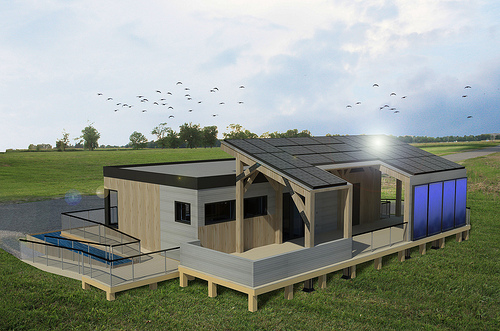
Team Ontario’s Solar Decathlon design with solar thermal.
It’s exciting to see what’s next in architecture and how young architects are integrating solar hot water and solar heating into their building designs. Below are several video examples from the 2013 Solar Decathlon, an international competition that invites colleges and universities to design an 800 sq. ft. solar home.
The 2013 Solar Decathlon, sponsored by the Dept of Energy, will take place from October 3 – October 13 in Orange County Great Park down in Irvine, California. (Free Hot Water advised the Santa Clara University team, a university that’s near our San Jose headquarters.)
While the competition does not require solar thermal, many designers have included it. Solar hot water is one of the judging criteria and is worth 100 points. To win those points, the teams must successfully complete several 15-gallon “hot water draws.” Specifically, the design needs to deliver 15 gallons (56.8 l) of hot water (110°F/43.3°C) in 10 minutes or less.
Here’s how some of the competition’s architects and engineers are using solar thermal technologies to win those points:
Santa Clara University
- The radiant heating and cooling system embedded in the ceiling drywall uses radiant panels to heat the house with hot water or cool the house with cold water—ensuring a uniform environment.
- As part of the water heating and storage system, a solar thermal panel supplies heat to a tank containing organic phase-change material. This tank is used to maintain the temperature of the domestic hot water system.
Southern California Institute of Architecture and California Institute of Technology
- The HVAC system uses state-of-the-art solar water heating technology with solar thermal evacuated tube collectors to maintain a comfortable interior temperature.
- A house monitoring system collects solar energy production data, monitors energy and water consumption, and controls indoor temperatures.
Team Ontario: Queen’s University, Carleton University, and Algonquin College
- A sloped exostructure holds the solar thermal systems and is designed to maximize the benefits of passive shading.
- A unique wall structure, along with vacuum insulation panels, enables the house to withstand harsh Ontario weather with an insulating capacity more than twice that of a conventional home.
- An integrated mechanical system provides space heating, cooling, dehumidification, and domestic hot water through a single system.
The University of North Carolina at Charlotte
- A hybrid passive-active hydronic radiant heating and cooling system uses only pump energy to control temperature, unlike conventional hydronic systems.
- A system of embedded “capillary” tubes circulates cool water through the high-mass, pre-cast concrete walls and up to a heat exchanger mounted on the roof, removing heat accumulated in the walls and resulting in cooling without the use of compressors or refrigerants.
Team Capitol DC: The Catholic University of America, George Washington University, and American University
- PV and flat-plate solar thermal systems produce electricity for the house and heat the domestic hot water.
- A unique under-floor heating and cooling distribution system supplies air at floor-level from ductwork connected to a central air handler located in the mechanical closet, allowing less stale air to be mixed with the fresh air and enabling the air handler to work more efficiently.
Kentucky/Indiana University
- A solar water heating system integrated with the HVAC system increases the overall energy efficiency by sharing energy between the house systems through hot and cold air recovery.
As Intersolar award winners for our own solar thermal design, Free Hot Water would like to congratulate these young designers and engineers for thinking about the new ways that solar thermal technologies can be integrated into homes.
Free Hot Water mainly focuses on commercial solar installations for apartment buildings, hotels, breweries, laundromats, and other heating and cooling applications. But we enjoy working with all architects on their unique vision for aesthetically integrating solar water heating into their designs. If you’re an architect with any question about solar hot water, please feel free to reach out to us. We’d love to help.




















